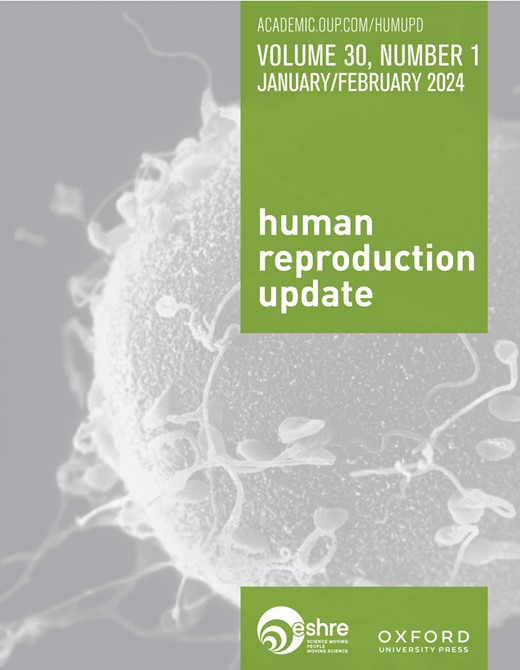采用新鲜和冷冻胚胎移植进行抗逆转录病毒治疗后怀孕的1-18岁儿童的BMI:一项系统综述和荟萃分析
IF 16.1
1区 医学
Q1 OBSTETRICS & GYNECOLOGY
引用次数: 0
摘要
根据所采用的特定ART方法,通过ART孕育的儿童表现出不同的出生体重。冷冻胚胎移植(FET)后出生的孩子更容易出生时体重高,出生时胎龄大,而新鲜胚胎移植(fresh- et)后出生的孩子往往出生时体重较低,更常被归类为胎龄小。大量研究已经证实,出生体重高低与儿童肥胖风险增加之间存在联系。一种流行的假设认为ART可能在受精、着床和早期胚胎阶段诱导表观遗传修饰,不仅影响出生时的大小,还影响后代以后的体重指数和整体健康。目的和理由本系统综述旨在确定文献中现有证据是否支持ART后出生的儿童与自然受孕的儿童相比BMI受到影响的假设。检索方法在PubMed (MEDLINE)、EMBASE和Cochrane数据库中使用医学主题标题、emtree术语和自由文本词进行文献检索,直至2025年3月20日。纳入标准为1-18岁ART后出生儿童的生长和人体测量(包括BMI)。根据PRISMA指南进行审查,并尽可能从纳入的研究中提取数据。使用Robins-I工具评估偏倚,使用GRADE评估纳入研究证据的确定性。结果:剔除重复项后,共发现22 026项研究。其中,80篇文章被挑选出来进行全文通读。此外,从参考文献列表中确定了52项研究,并将其纳入全文通读。在这132项研究中,有32项符合纳入标准,被纳入定性分析。进行了三项荟萃分析。第一个(A)比较了ART后出生的儿童(n = 8902)和自然受孕后出生的儿童(n = 61 818)的BMI作为SD评分(SDS),结果发现BMI无差异(mean-difference 0.02, 95% CI: -0.03;0.06), I2 = 9%,中等确定性)。第二个(B)研究了ART后出生的儿童(n = 4297)和NC后出生的儿童(n = 37233)的BMI (kg/m2)的差异,结果显示BMI略有下降,为-0.16 kg/m2 (95% CI: -0.26;-0.07), I2=87%,中等确定性)。第三项荟萃分析(C)检查了FET后出生的儿童(n = 5146)与新鲜et后出生的儿童(n = 15 709)的BMI (SDS),结果显示BMI (SDS)无差异(平均差异0.08,95% CI: -0.02;0.18), I2=84%)。在纳入的32项研究中,当结合Robins-I和GRADE工具时,24项研究被归类为低质量证据,而8项研究被评为极低质量证据。更广泛的意义本系统综述对现有文献进行了全面总结,研究了ART后出生的儿童与自然受孕的儿童的BMI。它通过使用年龄和性别标准化值为该领域增加了新颖可靠的信息。这项系统综述和荟萃分析的结果令人放心。为了进一步了解ART人群的健康状况,有必要对通过包括冷冻保存在内的各种ART方法受孕的儿童和成人的身体组成进行纵向研究。注册号prospero crd42021257788。本文章由计算机程序翻译,如有差异,请以英文原文为准。
BMI in children aged 1-18 years conceived after ART with fresh and frozen embryo transfer: a systematic review and meta-analyses.
BACKGROUND
Children conceived by ART exhibit varying birthweights based on the specific ART method employed. Those born after frozen embryo transfer (FET) are more prone to being born with a high birthweight and more children are born large-for-gestational age, while those born after fresh embryo transfer (fresh-ET) tend to have lower birthweights and are more often categorized as small-for-gestational age. Extensive research has established a link between both low and high birthweight and an increased risk of childhood obesity. One of the prevailing hypotheses suggests that ART may induce epigenetic modifications during fertilization, implantation, and early embryonic stages, influencing not only size at birth but also BMI and overall health of the offspring later in life.
OBJECTIVE AND RATIONALE
This systematic review was undertaken to determine if available evidence in the literature supports the hypothesis that BMI is affected in children born after ART compared with naturally conceived children.
SEARCH METHODS
A literature search was performed until 20 March 2025, in PubMed (MEDLINE), EMBASE, and the Cochrane databases for original papers using medical subject headings, Emtree-terms, and free text words. The inclusion criteria were growth and anthropometrics (including BMI) in children born after ART aged 1-18 years. The review was done according to the PRISMA guidelines and data were extracted from the included studies whenever possible. The Robins-I tool was used to assess bias and GRADE was used to evaluate the certainty of the evidence in the included studies.
OUTCOMES
A total of 22 026 studies were found after removal of duplicates. Of these, 80 articles were selected for a full-length read-through. Additionally, 52 studies from the reference lists were identified and included for full-length read-through. Of these 132 studies, 32 met the inclusion criteria and were included in the qualitative analysis. Three meta-analyses were conducted. The first (A) compared BMI as SD scores (SDS) in children born after ART (n = 8902) with children born after natural conception (NC) (n = 61 818), and resulted in no difference in BMI (mean-difference 0.02, 95% CI: (-0.03; 0.06), I2 = 9%, moderate certainty). The second (B) investigated the difference in BMI (kg/m2) in children born after ART (n = 4297) and children born after NC (n = 37 233), and showed a slight decline in BMI of -0.16 kg/m2 (95% CI: (-0.26; -0.07), I2=87%, moderate certainty) in ART-conceived children versus NC children. The third meta-analysis (C) examined BMI (SDS) in children born after FET (n = 5146) compared with those born after fresh-ET (n = 15 709), and resulted in no difference in BMI (SDS) (mean-difference 0.08, 95% CI: (-0.02; 0.18), I2=84%) between FET and fresh-ET. Of the 32 studies included, 24 were classified as having low-quality evidence, while 8 were rated as very low quality, when combining the tools of Robins-I and GRADE.
WIDER IMPLICATIONS
This systematic review provides a comprehensive summary of the existing literature investigating the BMI of children born after ART compared with children conceived naturally. It adds novel and reliable information to the field by using age and sex-standardized values. The results of this systematic review and meta-analyses are reassuring. To further understand the health of the ART population, there is a need for longitudinal research on body composition among children and adults conceived through various ART methods including cryopreservation.
REGISTRATION NUMBER
PROSPERO CRD42021257788.
求助全文
通过发布文献求助,成功后即可免费获取论文全文。
去求助
来源期刊

Human Reproduction Update
医学-妇产科学
CiteScore
28.80
自引率
1.50%
发文量
38
期刊介绍:
Human Reproduction Update is the leading journal in its field, boasting a Journal Impact FactorTM of 13.3 and ranked first in Obstetrics & Gynecology and Reproductive Biology (Source: Journal Citation ReportsTM from Clarivate, 2023). It specializes in publishing comprehensive and systematic review articles covering various aspects of human reproductive physiology and medicine.
The journal prioritizes basic, transitional, and clinical topics related to reproduction, encompassing areas such as andrology, embryology, infertility, gynaecology, pregnancy, reproductive endocrinology, reproductive epidemiology, reproductive genetics, reproductive immunology, and reproductive oncology. Human Reproduction Update is published on behalf of the European Society of Human Reproduction and Embryology (ESHRE), maintaining the highest scientific and editorial standards.
 求助内容:
求助内容: 应助结果提醒方式:
应助结果提醒方式:


